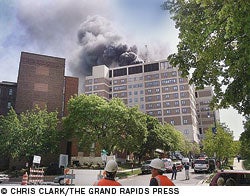Copter crash offers valuable lessons in disaster preparedness
 |
| The helicopter crash that occurred in 2008 at Butterworth Hospital, Grand Rapids, Mich., helped Spectrum Health officials tighten emergency preparedness plans. |
Nothing teaches disaster preparedness like experience. Just ask leaders at Spectrum Health, Grand Rapids, Mich.
In May 2008, during take-off and landing exercises atop Spectrum Health's Butterworth Hospital, a helicopter's tail rotor clipped a radio tower, causing it to crash on the helipad. A fire ensued and fuel from the chopper leaked into an elevator shaft, causing the evacuation of the 11-story patient tower and an interruption of power for about 25 minutes.
Tom Theoret, director of facilities support services for Spectrum Health, says the unusual set of circumstances created a "perfect storm" of emergency challenges.
"When you think of a disaster, usually you're thinking it will be one-dimensional — say, an electrical outage or a fire. This was multidimensional, from elevators and communications systems not working to sprinkler systems busting and fuel oil coming into the building," Theoret says.
No one was injured seriously, but the event led to significant disaster plan changes, many of which can serve as a lesson for others.
Since the crash, Spectrum Health has:
- implemented a 24-hour facilities management call center;
- dedicated roughly 3,000 square feet of space to an emergency command center and access to the center is restricted to a defined set of health system leaders;
- purchased two-way radios exclusively for emergency command center use;
- installed a larger helipad and a fire-suppression system;
- set up meetings with the fire department to better understand their command center setup and terminology;
- significantly increased disaster drills.
Julie Bulson, R.N., Spectrum Health director of emergency preparedness, says her organization in 2011 conducted 13 disaster planning exercises and had 41 real-life events, meaning that the system's command center was activated. That's more than double the number performed in 2008. "Real-life events aren't necessarily community disasters, but organizationally they were at a crisis level where we needed to have an organized response," Bulson says.
In her talks with other health care systems about what was learned from the events of May 2008, Bulson stresses the following three points:
Automate emergency plans. Perform exercises until staff instinctively know how to respond, as they do when codes are called. Spectrum Health conducts monthly exercises with electricians so they'll know how to isolate power throughout the complex without putting patients, visitors or staff in danger, Bulson says.
Discourage self-deployment of staff. Make sure staff know where to deploy during an emergency. Spectrum Health has developed a virtual personnel pool; staff in this group wait to hear from the command center on where to deploy and can stay productive in their area until needed.
Build successful, tested relationships. Police and fire officials often use different terminology and may have expectations about where a hospital's command center will be and how to reach key facility decision-makers in a crisis.
Be sure there is a common understanding of these issues before a disaster occurs.




